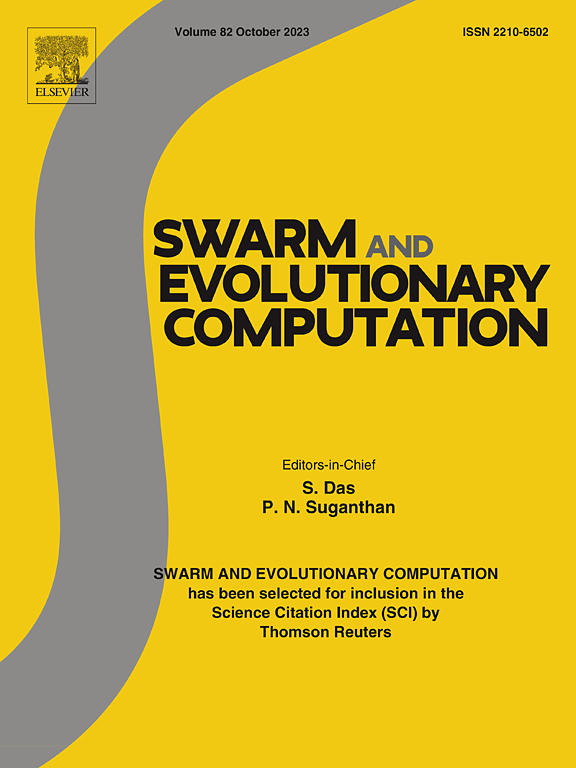混合元启发式图像水印算法的实验研究
IF 8.5
1区 计算机科学
Q1 COMPUTER SCIENCE, ARTIFICIAL INTELLIGENCE
引用次数: 0
摘要
不可见图像水印是一种很有前途的保护数字图像(如照片、插图和扫描)版权的方法。一种有效的水印算法是在图像中嵌入一个特殊的标记,该标记不会改变图像的内容,即使经过一些常见的后处理操作(如裁剪或压缩)也可以从中提取出来。许多作者使用元启发式优化算法来实现嵌入的不可感知性和鲁棒性之间的权衡。近年来,研究人员对混合元启发式方法很感兴趣,它以某种方式结合了单个元启发式的操作。然而,混合元启发式图像水印优化方案的设计和组成迄今尚未得到充分的研究。本文对遗传算法、差分进化算法、粒子群优化算法、萤火虫算法和人工蜂群算法等常用的生物优化算法进行了序列、交错和并行等混合元启发式的实验研究。以一种基于改变离散余弦变换系数组和的绝对值之比的算法为例,评价了混合元启发式算法在图像水印中的有效性,并对不同方案进行了实验比较。研究结果表明,一种元启发式杂交方法和混合方案的组成对图像水印算法的不可感知性和鲁棒性有显著影响。其中,交错杂交类型为算法提供了最好的结果。本文章由计算机程序翻译,如有差异,请以英文原文为准。
Hybrid metaheuristic algorithms for image watermarking: An experimental study
Invisible image watermarking is a promising method for protecting the copyright of digital images such as photographs, illustrations, and scans. An effective watermarking algorithm embeds a special mark into an image that does not change the image content but can be extracted from it even after some common post-processing operations such as cropping or compression. Many authors use metaheuristic optimization algorithms to achieve a trade-off between imperceptibility and robustness of embedding. In recent years, researchers have been interested in hybrid metaheuristics, which combine operations of individual metaheuristics in some way. However, designs and compositions of hybrid metaheuristic optimization schemes for image watermarking have not been sufficiently studied to date. In this paper, we present an experimental study of various hybrid metaheuristics including sequential, interleaved, and parallel schemes for popular bioinspired optimization algorithms including genetic algorithm, differential evolution algorithm, particle swarm optimization algorithm, firefly algorithm, and artificial bee colony algorithm. We evaluate the effectiveness of hybrid metaheuristics for image watermarking using an algorithm based on changing the ratio between absolute values of sums of discrete cosine transform coefficient groups as an example and perform an experimental comparison of different schemes. The results of the study show that a approach to metaheuristic hybridization and a composition of hybrid scheme significantly affect the imperceptibility and robustness of the image watermarking algorithm. In particular, the interleaved hybridization type provides the best results for the algorithm under consideration.
求助全文
通过发布文献求助,成功后即可免费获取论文全文。
去求助
来源期刊

Swarm and Evolutionary Computation
COMPUTER SCIENCE, ARTIFICIAL INTELLIGENCEC-COMPUTER SCIENCE, THEORY & METHODS
CiteScore
16.00
自引率
12.00%
发文量
169
期刊介绍:
Swarm and Evolutionary Computation is a pioneering peer-reviewed journal focused on the latest research and advancements in nature-inspired intelligent computation using swarm and evolutionary algorithms. It covers theoretical, experimental, and practical aspects of these paradigms and their hybrids, promoting interdisciplinary research. The journal prioritizes the publication of high-quality, original articles that push the boundaries of evolutionary computation and swarm intelligence. Additionally, it welcomes survey papers on current topics and novel applications. Topics of interest include but are not limited to: Genetic Algorithms, and Genetic Programming, Evolution Strategies, and Evolutionary Programming, Differential Evolution, Artificial Immune Systems, Particle Swarms, Ant Colony, Bacterial Foraging, Artificial Bees, Fireflies Algorithm, Harmony Search, Artificial Life, Digital Organisms, Estimation of Distribution Algorithms, Stochastic Diffusion Search, Quantum Computing, Nano Computing, Membrane Computing, Human-centric Computing, Hybridization of Algorithms, Memetic Computing, Autonomic Computing, Self-organizing systems, Combinatorial, Discrete, Binary, Constrained, Multi-objective, Multi-modal, Dynamic, and Large-scale Optimization.
 求助内容:
求助内容: 应助结果提醒方式:
应助结果提醒方式:


